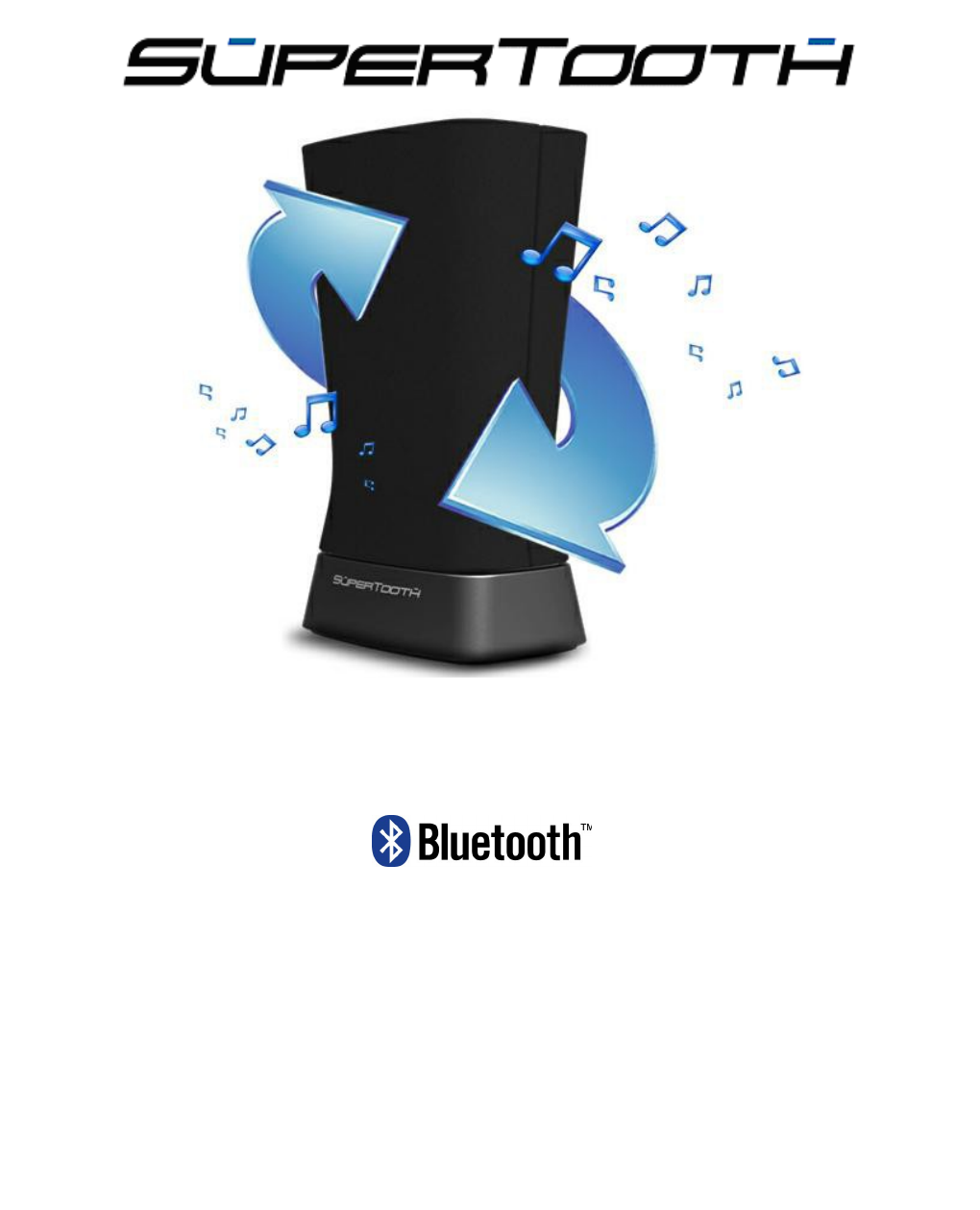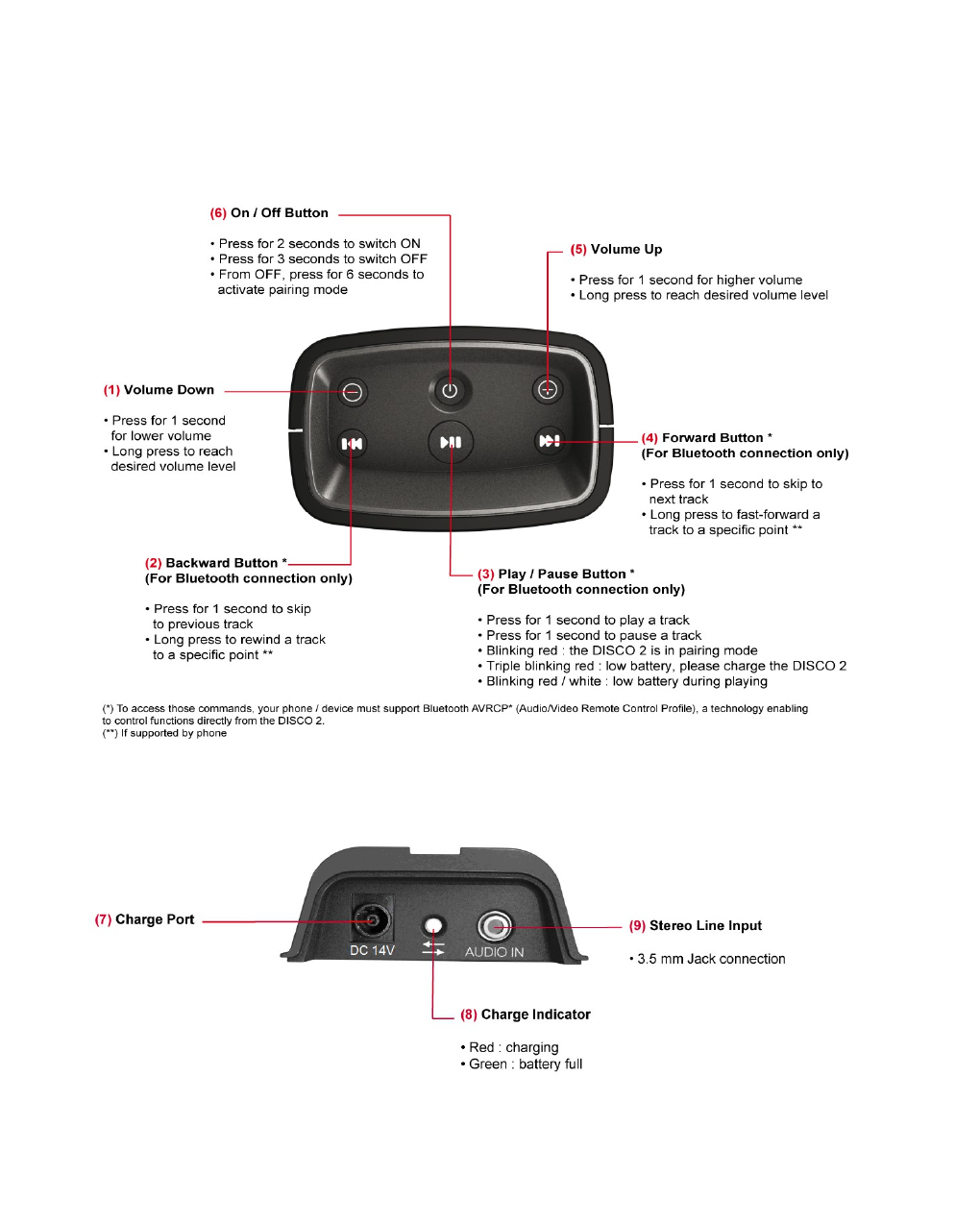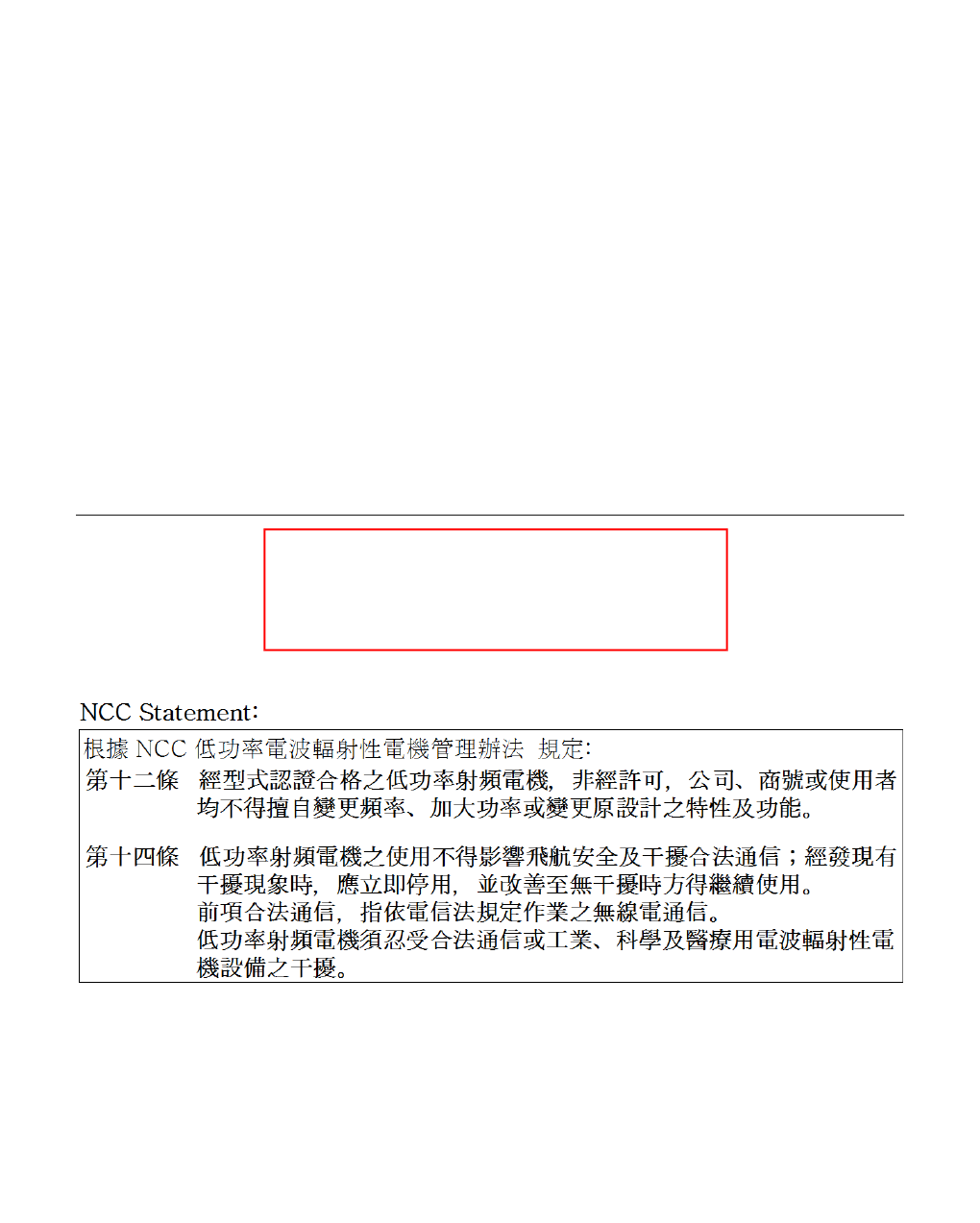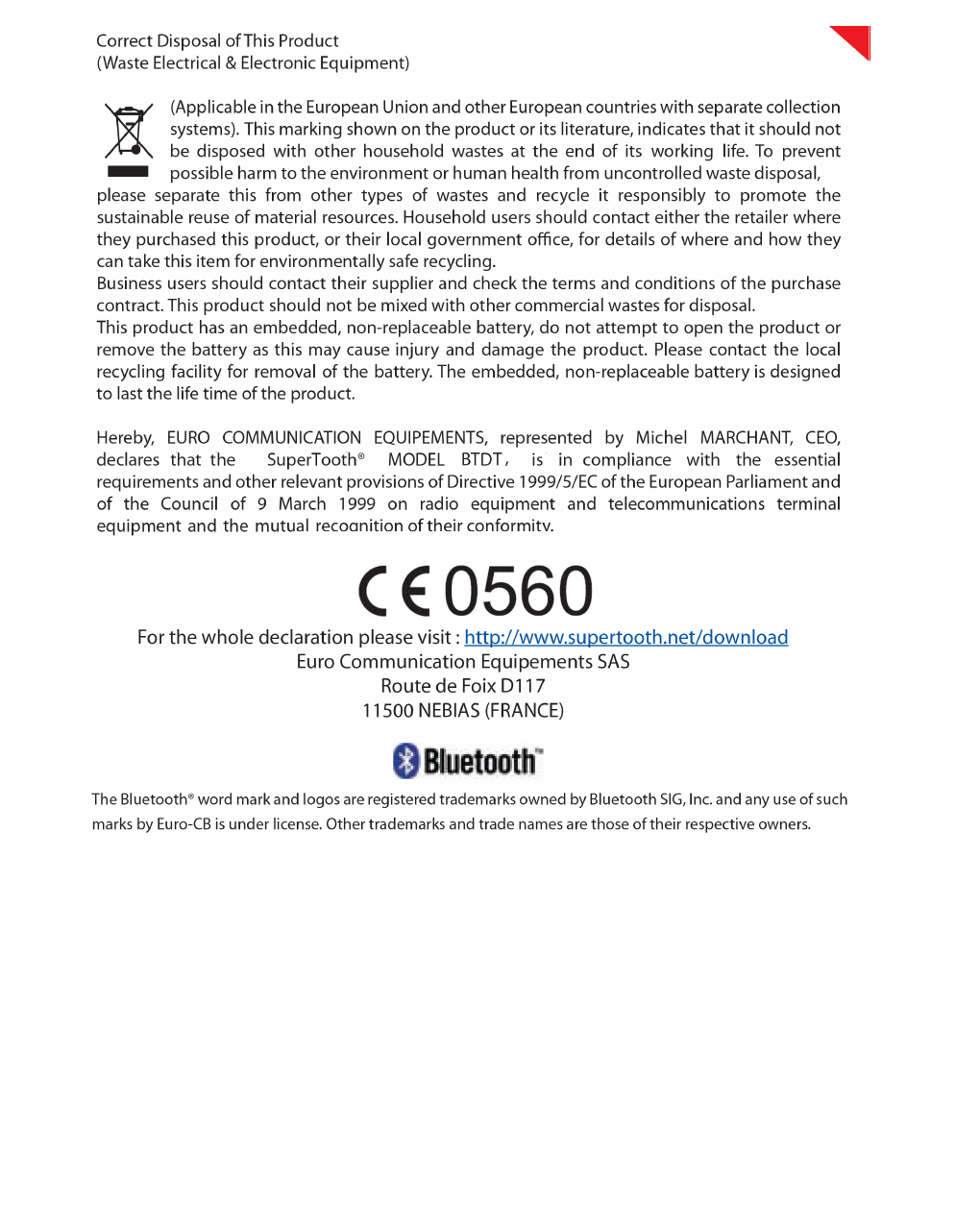Euro Communication EquipementS BTDT BTDT User Manual ST Sound Blaster
Euro Communication Equipement SAS BTDT ST Sound Blaster
manual

SUPERTOOTH DISCO TWIN
The portable Bluetooth A2DP stereo speaker
with 2 speakers on the front & 1 bass reflex system at the back.
You’ll be blown away by 16 Watts of high & outstanding audio quality!
The SUPERTOOTH DISCO TWIN is a portable, wireless stereo speaker featuring an avant-
garde design and compact footprint. Users can stream music wirelessly from any cell phone,
tablet, computer, laptop or Mp3 player supporting Bluetooth A2DP. The SUPERTOOTH DISCO
TWIN kicks out 16 watts RMS audio power, with two speakers on the front and a high efficiency
bass reflex system situated at the back of the unit. The integrated rechargeable battery ensures 3
to 4 hours of non-stop, maximum-volume music, and up to 10 hours of moderately played
melodies. The SUPERTOOTH DISCO TWIN comes with a 3.5 mm stereo jack cable for devices
that do not support Bluetooth A2DP.

Product Description
External Controls
Back View
2

Charging
1. Connect the charger’s plug into the Charge Port (7) of the SUPERTOOTH DISCO TWIN.
Connect the charger to an external power source.
2. The Charge Indicator (8) is steady red while charging. Charging is complete when the
Charge Indicator (8) goes green.
Turning the SUPERTOOTH DISCO TWIN On and Off
Power On : Press and hold the On / Off Button (6) for 2 seconds. A power on beep is heard in
the speaker, all the buttons switch on and off automatically.
Note 1 : At first time use, when you turn it on, the SUPERTOOTH DISCO TWIN goes to pairing
mode automatically (ready to be paired with your phone / device).
Note 2 : If you are not playing music, the SUPERTOOTH DISCO TWIN goes to standby mode
automatically after a few seconds and all the buttons switch off. To check it is
turned on, press any button. All the buttons switch on and off instantaneously.
Power Off : Press and hold the On / Off Button (6) for 3 seconds. A power off beep is heard
in the speaker.
Pairing the SUPERTOOTH DISCO TWIN with your Bluetooth A2DP
Phone/Device
Pair the SUPERTOOTH DISCO TWIN with your phone/device to create the link or audio
connection between the two. Pairing should be done at first connection to a phone/device.
Important : Make sure that your phone/device supports Bluetooth A2DP* (Advanced Audio
Distribution Profile) before proceeding.
Note : Any other device previously paired with the SUPERTOOTH DISCO TWIN must be turned
off, or its Bluetooth must be disabled before proceeding.
1. The SUPERTOOTH DISCO TWIN must be turned OFF. Press and hold the On / Off Button
(6) for 6 seconds until the Play / Pause Button (3) blinks red fast. The SUPERTOOTH DISCO
TWIN is ready to be paired.
2. While the SUPERTOOTH DISCO TWIN is in pairing mode, access the Bluetooth menu of your
phone. Turn on its Bluetooth function then execute a Bluetooth search to find the SUPERTOOTH
DISCO TWIN. (See your phone manual).
3. When your phone displays the list of Bluetooth devices, select ST DISCO TWIN.
4. If your phone asks for a password / pin code, enter 0000 and press OK.
5. The SUPERTOOTH DISCO TWIN beeps twice. It is ready to use with your phone.
*A2DP (Advanced Audio Distribution Profile) is a technology enabling to stream stereo sound
from an audio source (phone, PC, laptop, tablet, Mp3 player) to a stereo speaker or headset via
Bluetooth. To do so both devices must support this profile.
Using the SUPERTOOTH DISCO TWIN with your Bluetooth A2DP Phone/Device
3

Important : The SUPERTOOTH DISCO TWIN needs to be ‘paired’ with your Bluetooth A2DP
phone/device first. Please refer to “Pairing the SUPERTOOTH DISCO TWIN with your
Phone/Device” section.
Reconnecting the SUPERTOOTH DISCO TWIN with a Bluetooth A2DP phone / device
already paired
When your turn it on, the SUPERTOOTH DISCO TWIN reconnects automatically with the latest
paired device. When you leave the Bluetooth operating range, with the SUPERTOOTH DISCO
TWIN turned ON, it disconnects. When you come back into the Bluetooth operating range, press
the Play / Pause Button (3) for 1 second to reconnect the latest paired device. The
SUPERTOOTH DISCO TWIN beeps twice.
Streaming Music from a Bluetooth A2DP Phone/Device
1. Go to your phone music player and play a track by pressing “Play” or the Play / Pause Button
(3) for 1 second. If the SUPERTOOTH DISCO TWIN is connected, the music will be heard
directly in the speaker. See your phone manual if needed.
2. Audio is now on the SUPERTOOTH DISCO TWIN. All the buttons switch on steady white,
indicating that the phone is connected and streaming music via the SUPERTOOTH DISCO
TWIN.
3. When it is connected, you can control the music using the buttons of the SUPERTOOTH
DISCO TWIN. Please refer to “SUPERTOOTH DISCO TWIN Button Functions” section.
SUPERTOOTH DISCO TWIN Button Functions (for Bluetooth connection only)
The following functions can be controlled using the buttons on the SUPERTOOTH DISCO TWIN.
To do so, your phone/device must support Bluetooth AVRCP* (Audio/Video Remote Control
Profile), a technology enabling to control functions directly from the SUPERTOOTH DISCO
TWIN.
For streaming Bluetooth A2DP Music
To play a track, press the Play/Pause Button (3) for 1 second.
To pause a track, press the Play/Pause Button (3) for 1 second.
To skip to the next track, press the Forward Button (4) for 1 second.
To skip to the previous track, press the Backward Button (2) for 1 second.
To fast-forward a track at a specific point, press and hold the Forward Button (4) then
release to resume.
To rewind a track at a specific point, press and hold the Backward Button (2) then release
to resume.
To increase the volume level, press the Volume Up Button (5) for 1 second or hold the
button until you reach the desired volume level.
To decrease the volume level, press the Volume Down Button (1) for 1 second or hold
the button until you reach the desired volume level.
* Audio/Video Remote Control Profile is a Bluetooth profile that allows Bluetooth devices to
control media playback on remote devices.
4

Using the SUPERTOOTH DISCO TWIN with a non Bluetooth A2DP Mp3 Player
You can connect directly an Mp3 player via the Stereo Line Input (9) situated at the back of the
SUPERTOOTH DISCO TWIN.
Connecting directly a non Bluetooth A2DP Mp3 player with the SUPERTOOTH DISCO
TWIN
1. Plug one end of the supplied audio cable into the Stereo Line Input (9) and the other end into
the output of your music player.
2. Press “Play” on your Mp3 player to stream music directly via the SUPERTOOTH DISCO
TWIN.
3. Non Bluetooth devices won’t support Play / Pause / Previous / Next commands from the
SUPERTOOTH DISCO TWIN. Please use the buttons of your Mp3 player directly.
Clearing settings or Reset
Clearing the pairing settings of the speaker
1. Put the speaker to pairing mode: from OFF, press and hold the On/Off Button (6) for 6
seconds until the Play/Pause Button (3) blinks red fast
2. Press and hold the Play/Pause Button (3) for over 5 seconds until a beep is heard. The
pairing list is now erased.
Hardware resetting the speaker
Press and hold the On/Off Button (6) for over 35 seconds until the speaker turns off.
SUPERTOOTH DISCO TWIN specifications
Bluetooth Compliance:
Bluetooth version 3.0 specifications
Supported Bluetooth Profiles:
- A2DP (Advanced Audio Distribution Profile)
- Stereo music streaming
- AVRCP (Audio/Video Remote Control Profile)
Operating Range:
10 meters Bluetooth standard
Frequency:
2.4 GHZ
Battery and Battery Life:
Battery type: NI MH Power pack
Music playing time (maximum volume level): 3 to 4 hours
Music playing time (medium volume): 10 hours
Stand-by time: 1500 hours
Charging time: 2 hours
5

Audio Features:
Dual high efficiency speakers + bass reflex system
16 Watt RMS power
Compatible with any Bluetooth A2DP phone, PC, laptop, tablet or MP3 player
Jack 3.5 auxiliary input for non Bluetooth A2DP Mp3 players, iPods or computers
Wireless Play / Previous / Next / Pause / Volume control (AVRCP standard)
Multipairing:
Maximum 8 phones paired
1 phone connected at a time
Special Features:
Low battery / Charging indicator
Illuminated controls
Size and weight:
Height: 182 mm
Width: 108 mm
Depth: 70 mm
Weight: 552.7 g
6
CAUTION
RISK OF EXPLOSION IF BATTERY IS REPLACED
BY AN INCORRECT TYPE.
DISPOSE OF USED BATTERIES ACCORDING
TO THE INSTRUCTIONS

7

FCC/IC statements :
Federal Communications Commission (FCC) Statement
Industry Canada (IC) Statement
15.21
You are cautioned that changes or modifications not expressly approved by the part responsible
for compliance could void the user’s authority to operate the equipment.
15.105(b)
This equipment has been tested and found to comply with the limits for a Class B digital device,
pursuant to part 15 of the FCC/IC rules. These limits are designed to provide reasonable
protection against harmful interference in a residential installation. This equipment generates,
uses and can radiate radio frequency energy and, if not installed and used in accordance with the
instructions, may cause harmful interference to radio communications. However, there is no
guarantee that interference will not occur in a particular installation. If this equipment does cause
harmful interference to radio or television reception, which can be determined by turning the
equipment off and on, the user is encouraged to try to correct the interference by one or more of
the following measures :
-Reorient or relocate the receiving antenna.
-Increase the separation between the equipment and receiver.
-Connect the equipment into an outlet on a circuit different from that to which the receiver is
connected.
-Consult the dealer or an experienced radio/TV technician for help.
This device complies with Industry Canada licence-exempt RSS standard(s)
Operation is subject to the following two conditions :
1)This device may not cause interference and
2)This device must accept any interference, including interference that may cause undesired
operation of the device.
FCC/IC RF Radiation Exposure Statement :
This equipment complies with FCC/IC radiation exposure limits set forth for an
uncontrolled environment. End users must follow the specific operating instructions for
satisfying RF exposure compliance. This transmitter must not be co-located or operating
in conjunction with any other antenna or transmitter
8

Déclarations FCC / IC :
Commission Federale des Communications (FCC)
Déclaration Industrie Canada (IC)
15,21
Vous êtes averti que les changements modications non expressément approuvés par la partie
responsable de la conformité pourraient annuler l'autorité de l'utilisateur d'exploiter cet
équipement.
15.105 (b)
Cet équipement a été testé et jugé conforme aux limites pour un appareil numérique de classe
B, conformément à la partie 15 des règles de la FCC / IC. Ces limites sont conçues pour fournir
une protection raisonnable contre les interférences nuisibles dans une installation résidentielle.
Cet équipement génère, utilise et peut émettre des fréquences radio et, s'il n'est pas installé et
utilisé conformément aux instructions, peut causer des interférences nuisibles aux
communications radio. Cependant, il n'existe aucune garantie que ces interférences ne se
produiront pas dans une installation particulière. Si cet équipement provoque des interférences
nuisibles à la réception radio ou télévision, ce qui peut être déterminé en éteignant et rallumant
l'équipement, l'utilisateur est encouragé à essayer de corriger l'interférence par une ou plusieurs
des mesures suivantes:
- Réorienter ou déplacer l'antenne réceptrice.
- Augmenter distance entre l'équipement et le récepteur.
- Brancher l'équipement dans une sortie sur un circuit différents-de celui sur lequel est branché le
récepteur.
Consulter le revendeur ou un technicien radio / TV qualifié.
Cet appareil est conforme aux CNR d'Industrie Canada applicables aux appareils radio exempts
de licence.
L'opération est soumise aux deux conditions suivantes:
1) Cet appareil ne peut causer d'interférences et
2) Cet appareil doit accepter toute interférence, y compris les interférences qui peuvent causer
un mauvais fonctionnement de l'appareil.
FCC / IC Déclaration d'exposition aux radiations RF:
Cet équipement est conforme aux normes FCC / IC limites d'exposition aux radiations
dans un environnement non contrôlé. Les utilisateurs doivent suivre les instructions de
fonctionnement spéciques de la conformité d'exposition aux RF. Cet émetteur ne doit pas
être co-localisés ou fonctionnant en conjonction avec une autre antenne ou transmetteur.
9